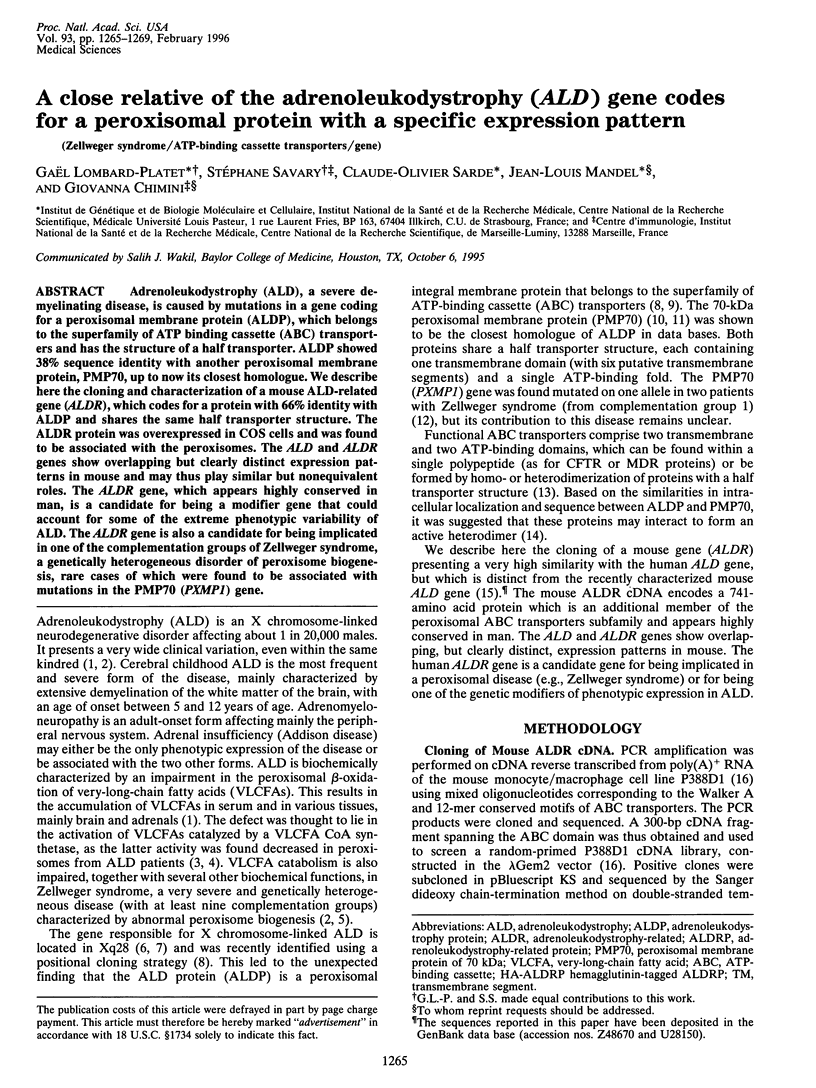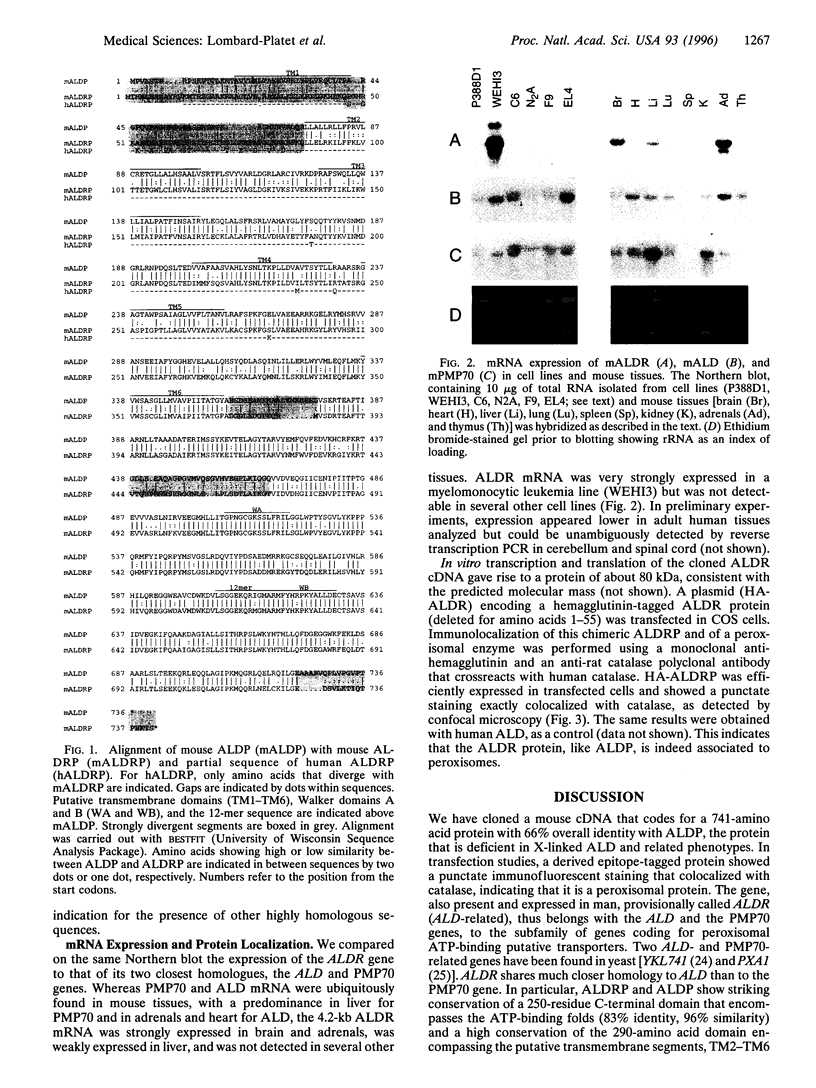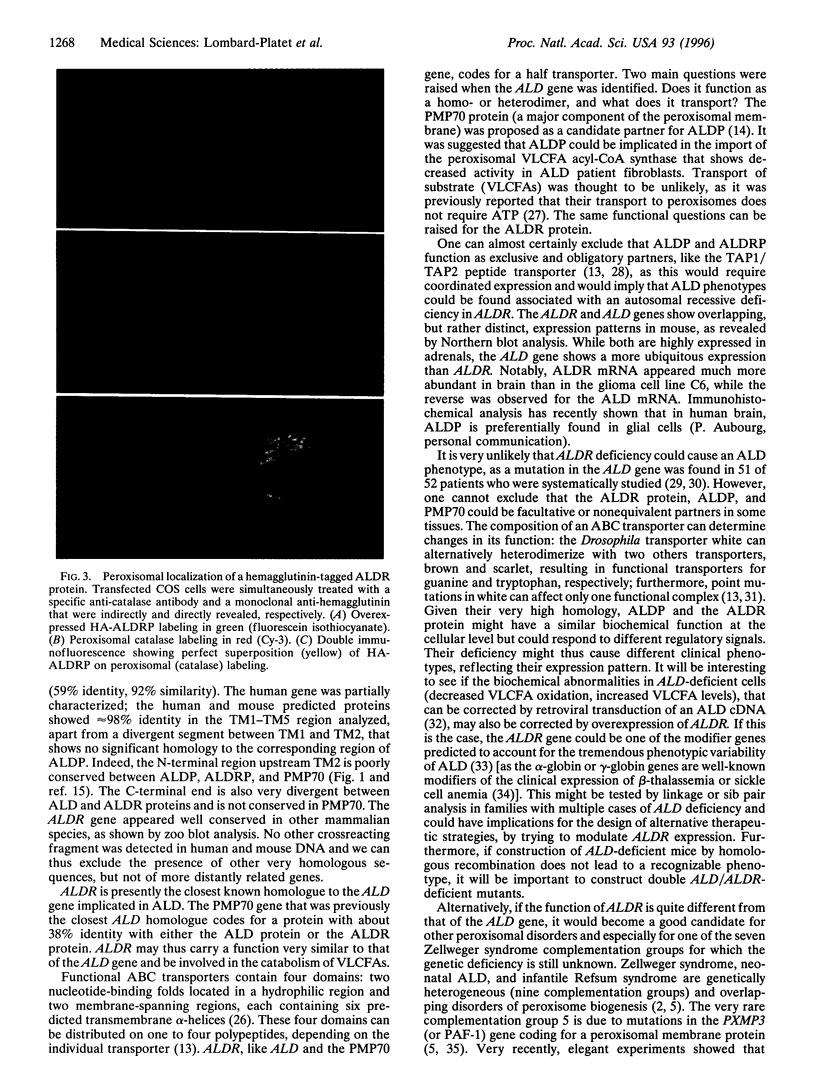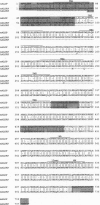Abstract
Adrenoleukodystrophy (ALD), a severe demyelinating disease, is caused by mutations in a gene coding for a peroxisomal membrane protein (ALDP), which belongs to the superfamily of ATP binding cassette (ABC) transporters and has the structure of a half transporter. ALDP showed 38% sequence identity with another peroxisomal membrane protein, PMP70, up to now its closest homologue. We describe here the cloning and characterization of a mouse ALD-related gene (ALDR), which codes for a protein with 66% identity with ALDP and shares the same half transporter structure. The ALDR protein was overexpressed in COS cells and was found to be associated with the peroxisomes. The ALD and ALDR genes show overlapping but clearly distinct expression patterns in mouse and may thus play similar but nonequivalent roles. The ALDR gene, which appears highly conserved in man, is a candidate for being a modifier gene that could account for some of the extreme phenotypic variability of ALD. The ALDR gene is also a candidate for being implicated in one of the complementation groups of Zellweger syndrome, a genetically heterogeneous disorder of peroxisome biogenesis, rare cases of which were found to be associated with mutations in the PMP70 (PXMP1) gene.
Full text
PDF




Images in this article
Selected References
These references are in PubMed. This may not be the complete list of references from this article.
- Aubourg P. R., Sack G. H., Jr, Meyers D. A., Lease J. J., Moser H. W. Linkage of adrenoleukodystrophy to a polymorphic DNA probe. Ann Neurol. 1987 Apr;21(4):349–352. doi: 10.1002/ana.410210406. [DOI] [PubMed] [Google Scholar]
- Ben Hamida C., Doerflinger N., Belal S., Linder C., Reutenauer L., Dib C., Gyapay G., Vignal A., Le Paslier D., Cohen D. Localization of Friedreich ataxia phenotype with selective vitamin E deficiency to chromosome 8q by homozygosity mapping. Nat Genet. 1993 Oct;5(2):195–200. doi: 10.1038/ng1093-195. [DOI] [PubMed] [Google Scholar]
- Bossier P., Fernandes L., Vilela C., Rodrigues-Pousada C. The yeast YKL741 gene situated on the left arm of chromosome XI codes for a homologue of the human ALD protein. Yeast. 1994 May;10(5):681–686. doi: 10.1002/yea.320100512. [DOI] [PubMed] [Google Scholar]
- Cartier N., Lopez J., Moullier P., Rocchiccioli F., Rolland M. O., Jorge P., Mosser J., Mandel J. L., Bougnères P. F., Danos O. Retroviral-mediated gene transfer corrects very-long-chain fatty acid metabolism in adrenoleukodystrophy fibroblasts. Proc Natl Acad Sci U S A. 1995 Feb 28;92(5):1674–1678. doi: 10.1073/pnas.92.5.1674. [DOI] [PMC free article] [PubMed] [Google Scholar]
- Denizot F., Mattei M. G., Vernet C., Pontarotti P., Chimini G. YAC-assisted cloning of a putative G-protein mapping to the MHC class I region. Genomics. 1992 Dec;14(4):857–862. doi: 10.1016/s0888-7543(05)80105-3. [DOI] [PubMed] [Google Scholar]
- Devys D., Lutz Y., Rouyer N., Bellocq J. P., Mandel J. L. The FMR-1 protein is cytoplasmic, most abundant in neurons and appears normal in carriers of a fragile X premutation. Nat Genet. 1993 Aug;4(4):335–340. doi: 10.1038/ng0893-335. [DOI] [PubMed] [Google Scholar]
- Dodt G., Braverman N., Wong C., Moser A., Moser H. W., Watkins P., Valle D., Gould S. J. Mutations in the PTS1 receptor gene, PXR1, define complementation group 2 of the peroxisome biogenesis disorders. Nat Genet. 1995 Feb;9(2):115–125. doi: 10.1038/ng0295-115. [DOI] [PubMed] [Google Scholar]
- Ewart G. D., Cannell D., Cox G. B., Howells A. J. Mutational analysis of the traffic ATPase (ABC) transporters involved in uptake of eye pigment precursors in Drosophila melanogaster. Implications for structure-function relationships. J Biol Chem. 1994 Apr 8;269(14):10370–10377. [PubMed] [Google Scholar]
- Feinberg A. P., Vogelstein B. A technique for radiolabeling DNA restriction endonuclease fragments to high specific activity. Anal Biochem. 1983 Jul 1;132(1):6–13. doi: 10.1016/0003-2697(83)90418-9. [DOI] [PubMed] [Google Scholar]
- Gärtner J., Moser H., Valle D. Mutations in the 70K peroxisomal membrane protein gene in Zellweger syndrome. Nat Genet. 1992 Apr;1(1):16–23. doi: 10.1038/ng0492-16. [DOI] [PubMed] [Google Scholar]
- Higgins C. F. ABC transporters: from microorganisms to man. Annu Rev Cell Biol. 1992;8:67–113. doi: 10.1146/annurev.cb.08.110192.000435. [DOI] [PubMed] [Google Scholar]
- Hyde S. C., Emsley P., Hartshorn M. J., Mimmack M. M., Gileadi U., Pearce S. R., Gallagher M. P., Gill D. R., Hubbard R. E., Higgins C. F. Structural model of ATP-binding proteins associated with cystic fibrosis, multidrug resistance and bacterial transport. Nature. 1990 Jul 26;346(6282):362–365. doi: 10.1038/346362a0. [DOI] [PubMed] [Google Scholar]
- Kamijo K., Kamijo T., Ueno I., Osumi T., Hashimoto T. Nucleotide sequence of the human 70 kDa peroxisomal membrane protein: a member of ATP-binding cassette transporters. Biochim Biophys Acta. 1992 Feb 11;1129(3):323–327. doi: 10.1016/0167-4781(92)90510-7. [DOI] [PubMed] [Google Scholar]
- Kamijo K., Taketani S., Yokota S., Osumi T., Hashimoto T. The 70-kDa peroxisomal membrane protein is a member of the Mdr (P-glycoprotein)-related ATP-binding protein superfamily. J Biol Chem. 1990 Mar 15;265(8):4534–4540. [PubMed] [Google Scholar]
- Kastner P., Perez A., Lutz Y., Rochette-Egly C., Gaub M. P., Durand B., Lanotte M., Berger R., Chambon P. Structure, localization and transcriptional properties of two classes of retinoic acid receptor alpha fusion proteins in acute promyelocytic leukemia (APL): structural similarities with a new family of oncoproteins. EMBO J. 1992 Feb;11(2):629–642. doi: 10.1002/j.1460-2075.1992.tb05095.x. [DOI] [PMC free article] [PubMed] [Google Scholar]
- Kok F., Neumann S., Sarde C. O., Zheng S., Wu K. H., Wei H. M., Bergin J., Watkins P. A., Gould S., Sack G. Mutational analysis of patients with X-linked adrenoleukodystrophy. Hum Mutat. 1995;6(2):104–115. doi: 10.1002/humu.1380060203. [DOI] [PubMed] [Google Scholar]
- Lander E. S., Botstein D. Homozygosity mapping: a way to map human recessive traits with the DNA of inbred children. Science. 1987 Jun 19;236(4808):1567–1570. doi: 10.1126/science.2884728. [DOI] [PubMed] [Google Scholar]
- Lazo O., Contreras M., Bhushan A., Stanley W., Singh I. Adrenoleukodystrophy: impaired oxidation of fatty acids due to peroxisomal lignoceroyl-CoA ligase deficiency. Arch Biochem Biophys. 1989 May 1;270(2):722–728. doi: 10.1016/0003-9861(89)90555-9. [DOI] [PubMed] [Google Scholar]
- Ligtenberg M. J., Kemp S., Sarde C. O., van Geel B. M., Kleijer W. J., Barth P. G., Mandel J. L., van Oost B. A., Bolhuis P. A. Spectrum of mutations in the gene encoding the adrenoleukodystrophy protein. Am J Hum Genet. 1995 Jan;56(1):44–50. [PMC free article] [PubMed] [Google Scholar]
- Luciani M. F., Denizot F., Savary S., Mattei M. G., Chimini G. Cloning of two novel ABC transporters mapping on human chromosome 9. Genomics. 1994 May 1;21(1):150–159. doi: 10.1006/geno.1994.1237. [DOI] [PubMed] [Google Scholar]
- Meyer T. H., van Endert P. M., Uebel S., Ehring B., Tampé R. Functional expression and purification of the ABC transporter complex associated with antigen processing (TAP) in insect cells. FEBS Lett. 1994 Sep 12;351(3):443–447. doi: 10.1016/0014-5793(94)00908-2. [DOI] [PubMed] [Google Scholar]
- Migeon B. R., Moser H. W., Moser A. B., Axelman J., Sillence D., Norum R. A. Adrenoleukodystrophy: evidence for X linkage, inactivation, and selection favoring the mutant allele in heterozygous cells. Proc Natl Acad Sci U S A. 1981 Aug;78(8):5066–5070. doi: 10.1073/pnas.78.8.5066. [DOI] [PMC free article] [PubMed] [Google Scholar]
- Moser H. W., Moser A. B., Smith K. D., Bergin A., Borel J., Shankroff J., Stine O. C., Merette C., Ott J., Krivit W. Adrenoleukodystrophy: phenotypic variability and implications for therapy. J Inherit Metab Dis. 1992;15(4):645–664. doi: 10.1007/BF01799621. [DOI] [PubMed] [Google Scholar]
- Mosser J., Douar A. M., Sarde C. O., Kioschis P., Feil R., Moser H., Poustka A. M., Mandel J. L., Aubourg P. Putative X-linked adrenoleukodystrophy gene shares unexpected homology with ABC transporters. Nature. 1993 Feb 25;361(6414):726–730. doi: 10.1038/361726a0. [DOI] [PubMed] [Google Scholar]
- Mosser J., Lutz Y., Stoeckel M. E., Sarde C. O., Kretz C., Douar A. M., Lopez J., Aubourg P., Mandel J. L. The gene responsible for adrenoleukodystrophy encodes a peroxisomal membrane protein. Hum Mol Genet. 1994 Feb;3(2):265–271. doi: 10.1093/hmg/3.2.265. [DOI] [PubMed] [Google Scholar]
- Nadal N., Rolland M. O., Tranchant C., Reutenauer L., Gyapay G., Warter J. M., Mandel J. L., Koenig M. Localization of Refsum disease with increased pipecolic acidaemia to chromosome 10p by homozygosity mapping and carrier testing in a single nuclear family. Hum Mol Genet. 1995 Oct;4(10):1963–1966. doi: 10.1093/hmg/4.10.1963. [DOI] [PubMed] [Google Scholar]
- Sarde C. O., Mosser J., Kioschis P., Kretz C., Vicaire S., Aubourg P., Poustka A., Mandel J. L. Genomic organization of the adrenoleukodystrophy gene. Genomics. 1994 Jul 1;22(1):13–20. doi: 10.1006/geno.1994.1339. [DOI] [PubMed] [Google Scholar]
- Sarde C. O., Thomas J., Sadoulet H., Garnier J. M., Mandel J. L. cDNA sequence of Aldgh, the mouse homolog of the X-linked adrenoleukodystrophy gene. Mamm Genome. 1994 Dec;5(12):810–813. doi: 10.1007/BF00292021. [DOI] [PubMed] [Google Scholar]
- Shani N., Watkins P. A., Valle D. PXA1, a possible Saccharomyces cerevisiae ortholog of the human adrenoleukodystrophy gene. Proc Natl Acad Sci U S A. 1995 Jun 20;92(13):6012–6016. doi: 10.1073/pnas.92.13.6012. [DOI] [PMC free article] [PubMed] [Google Scholar]
- Shimozawa N., Suzuki Y., Orii T., Moser A., Moser H. W., Wanders R. J. Standardization of complementation grouping of peroxisome-deficient disorders and the second Zellweger patient with peroxisomal assembly factor-1 (PAF-1) defect. Am J Hum Genet. 1993 Apr;52(4):843–844. [PMC free article] [PubMed] [Google Scholar]
- Shimozawa N., Tsukamoto T., Suzuki Y., Orii T., Shirayoshi Y., Mori T., Fujiki Y. A human gene responsible for Zellweger syndrome that affects peroxisome assembly. Science. 1992 Feb 28;255(5048):1132–1134. doi: 10.1126/science.1546315. [DOI] [PubMed] [Google Scholar]
- Singh I., Lazo O., Dhaunsi G. S., Contreras M. Transport of fatty acids into human and rat peroxisomes. Differential transport of palmitic and lignoceric acids and its implication to X-adrenoleukodystrophy. J Biol Chem. 1992 Jul 5;267(19):13306–13313. [PubMed] [Google Scholar]
- Valle D., Gärtner J. Human genetics. Penetrating the peroxisome. Nature. 1993 Feb 25;361(6414):682–683. doi: 10.1038/361682a0. [DOI] [PubMed] [Google Scholar]
- Wanders R. J., van Roermund C. W., van Wijland M. J., Schutgens R. B., Schram A. W., Tager J. M., van den Bosch H., Schalkwijk C. X-linked adrenoleukodystrophy: identification of the primary defect at the level of a deficient peroxisomal very long chain fatty acyl-CoA synthetase using a newly developed method for the isolation of peroxisomes from skin fibroblasts. J Inherit Metab Dis. 1988;11 (Suppl 2):173–177. doi: 10.1007/BF01804228. [DOI] [PubMed] [Google Scholar]
- Yajima S., Suzuki Y., Shimozawa N., Yamaguchi S., Orii T., Fujiki Y., Osumi T., Hashimoto T., Moser H. W. Complementation study of peroxisome-deficient disorders by immunofluorescence staining and characterization of fused cells. Hum Genet. 1992 Mar;88(5):491–499. doi: 10.1007/BF00219334. [DOI] [PubMed] [Google Scholar]





